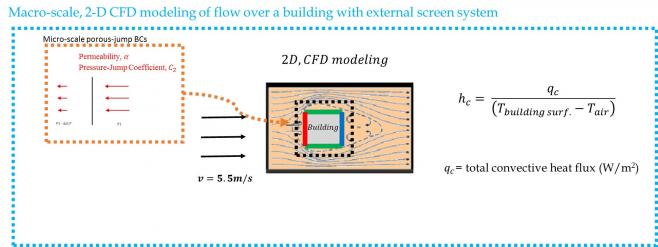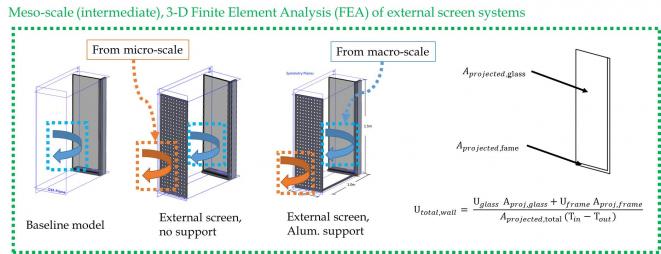Building Sustainability into Control Systems > Student Projects
*Past Student Projects:
Building Fault Diagnosis: Air-Handling Unit and Cogeneration Case Studies (Spring 2016)
A Methodology for Reducing Building Energy Usage (Spring 2014)
Degree of Comfort: A Thermal Comfort Study of 41 Cooper Square (Spring 2014)
@41CooperSquare: Energy Dashboard for an Educational Building in NYC (Spring 2014)
Creating an Energy Model of 41 Cooper Square (Spring 2013)
Laboratory Ventilation Energy Conservation Measures (Fall 2016)
*Building Fault Diagnosis: Air-Handling Unit and Cogeneration Case Studies (Spring 2016)
Alex Bush, ME ’16 and Joe Viola, ME ‘16
The goal of this project is to develop tools for building retuning which can facilitate the monitoring and verification of building data, increase energy efficiency, and reduce operational cost. The building retuning and fault diagnosis process was applied to air handlers and cogeneration plants at Cooper Union. This project developed tools in Matlab and Excel to analyze data from the Building Management System and cogen plants and investigate opportunties for energy and cost savings.

Click here for a PDF of the project poster.
*A Methodology for Reducing Building Energy Usage (Spring 2014)
Eric Leong, ME ’14 and Gregori Tayco, ME ‘14
Presented at 2014 ASEE Zone 1 Conference Student Poster Competition and 2014 NYC Dept. of Design and Construction’s (NYCDDC) Town+Gown and Industry City poster exhibits
Buildings sector comprises a large portion of energy consumption. Internationally, it represents 32% of global consumption 41% of U.S. energy consumption. Therefore it is critical to focus on the reduction of energy usage in existing buildings for reducing global energy consumption. This project focuses on The Cooper Union’s LEED Platinum certified academic building, 41 Cooper Square.
By observing its energy consumption, areas with the greatest potential for energy savings can be monitored to improve operational use and reduce energy usage. This project examines different methods to characterize energy use and proposes strategies to reduce consumption. Though this process was applied to 41 Cooper Square, the procedure is designed to be applicable to other building systems.
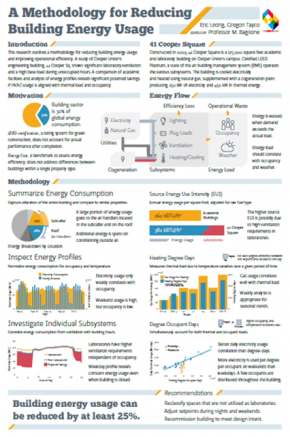
Click here for a PDF of the project poster
Click here for ASEE Zone 1 conference abstract
Click here for Senior Capstone Design report
*Technical and Economic Assessment of a Cogeneration System in an Urban Academic Building (Spring 2014)
Jonathan Rodriguez, MME ‘14
Presented at 2014 NYC Dept. of Design and Construction’s (NYCDDC) Town+Gown and Industry City poster exhibits
A technical and economic assessment of the 250 kW cogeneration system at 41 Cooper Square was performed using a mathematical simulation. The cogeneration system was commissioned in December 2011 with a capital investment of $1.2 million of which $400,000 was funded through a grant from the New York State Energy Research Development Authority (NYSERDA). The system as currently configured reduces annual utility expenses by about $101,000 per year compared to the direct purchase of electricity and natural gas from the utility grid. These savings account for the annual maintenance associated with cogeneration and represents a payback time of 8 years (equivalently a 13% return on Cooper Union’s investment). The analysis revealed four key deficiencies that hinder its full performance potential, all of which could be eliminated by modest physical retrofits each with favorable economic returns.
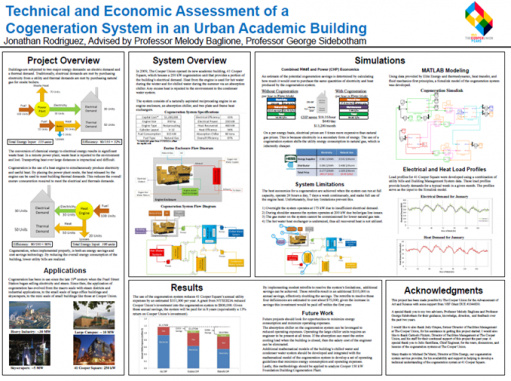
Click here for a PDF of the project poster
*Degree of Comfort: A Thermal Comfort Study of 41 Cooper Square (Spring 2014)
Yudi Guo, ME ’14 and Daniel Moreno, ME ‘14
Presented at 2014 NYC Dept. of Design and Construction’s (NYCDDC) Town+Gown and Industry City poster exhibits
The thermal comfort of an indoor environment is essential to maintaining occupant productivity and health. Comfort in 41 Cooper Square is primarily controlled by the radiant panels, which affect the air temperature in the room, and the air handling units (AHUs), which influence humidity and air speed. However, it is also highly subjective and can vary from person to person. This study assessed the overall comfort of the building using both Building Management System (BMS) data and results from surveys that were administered to building occupants, comparing them to a standardized scale used for evaluating comfort in building design. In the study it was found that overall, the building is generally perceived to be slightly cold, suggesting that comfort could be improved by raising room temperature set points, especially during summer months, or by reducing drafts by lowering ventilation rates whenever possible.
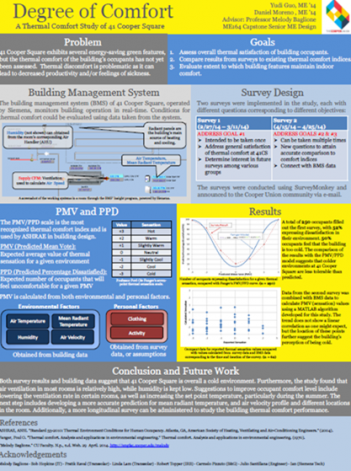
Click here for a PDF of the project poster
*@41CooperSquare: Energy Dashboard for an Educational Building in NYC (Spring 2014)
Janet Butler, ME ’14 and Polina Smirnova, ME ‘14
Presented at 2014 NYC Dept. of Design and Construction’s (NYCDDC) Town+Gown and Industry City poster exhibits
Highly efficient buildings often decrease in optimal energy performance after five years of occupancy. To prevent loss in energy efficiency, it is necessary to engage occupants in understanding the purpose of green features implemented in building operation. An energy dashboard was built to inform building occupants and engineering students on the effectiveness of wide array of green features located at 41 Cooper Square. A public website, at41coopersquare.github.io, was created and is hosted on a kiosk in the lobby of The Cooper Union’s academic building at 41 Cooper Square.

Click here for a PDF of the project poster
*Creating an Energy Model of 41 Cooper Square (Spring 2013)
Sara Carlson, ME ‘13
An energy model of 41 Cooper Square (41 CS) is made in the building simulation program eQUEST. The data used to populate the model is gathered from several sources including construction drawings of the building, the code and report of the energy model made by IBE Consulting Engineers, and the Siemens Building Management System (BMS). The resulting energy model is used to predict the building’s energy usage. The cost of annual combined gas and electric utilities is used as the basis to compare the accuracy of the energy model to 41 CS. The model predicts an annual energy cost of $1,036,000, which is within 10% of the actual utility costs for 2011, $934,000. The model is used to perform a sensitivity analysis on zone thermostat setpoints and predicts that increasing the cooling setpoint from 72°F to 76°F and reducing the heating setpoint from 72°F to 68°F will save approximately $38,000 in annual utility costs.
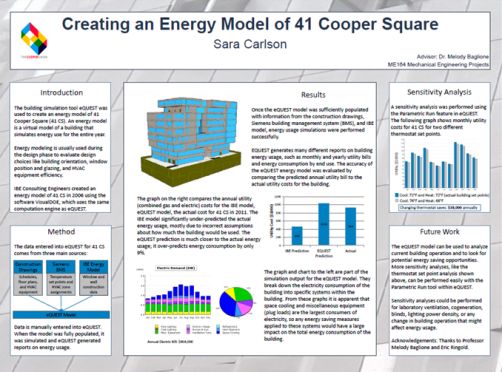
Click here for a PDF of the project poster
*Investigating thermal performance of double-skin perforated-sheet façade using multi-scale approach
Woojae Kim, MME '16
This thesis research investigates the insulating performance of screen systems, specifically, the combined effects of thermally bridging elements and wind sheltering, provided by external screens. In order to quantify these effects, U-factors of simple glazed wall assemblies with and without external screens were calculated and compared. To calculate the U-factors, this research proposes a multi-step modeling approach to minimize the computational costs of explicit modeling of screen systems. At various length scales, Computational Fluid Dynamics (CFD) modeling as well as thermal Finite Element Analysis (FEA) were used to analyze various components of screen systems and their thermal performances. From the analyses, it was concluded that the insulating benefits gained from the wind sheltering were marginal under the boundary conditions specified by the National Fenestration Rating Council (NFRC). The overall U-factors of façades with screen systems degraded due to the increased surface exposure and thermal bridging when compared to a baseline façade without any screen.
This research also investigates the solar shading performance of screen systems. In order to quantify the impacts of varying screen properties on overall building energy consumption, a commercial office space in New York, NY was simulated in COMFEN, an energy modeling software, and analyzed. For orientations where high solar irradiation is expected, solar shading from external screens resulted in overall energy savings by reducing the cooling loads. For orientations with marginal solar exposure, however, screen systems resulted in higher annual energy consumption due to increased lighting demand caused by blockage of visible light. Based on the analyses performed in this research, it was concluded that a screen system should be considered for a project after analyzing it for a specific site and quantifying the benefits it may provide throughout the life-cycle of the building.
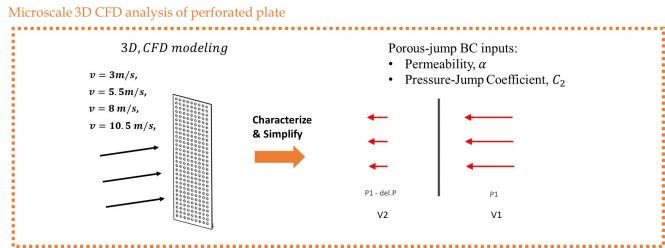
*The Application of Numerical Methods and Artificial Intelligence to the Building Management System in a LEED Certified Academic Building (41 Cooper Square)
Michael Sterman, MME '12
Presented at ASME 2012 International Mechanical Engineering Congress
In this Master's thesis, neural networks are applied to predict the energy consumption of a LEED-certified academic building (41 Cooper Square). A neural network model was validated to be accurate within an average absolute error of 33.4 kW, or approximately 5.0% of the total electricity consumption of the building, for weekdays when school was in session. Innovations in this neural network model include the use of solar position as a variable, which was incorporated to address 41CS’s specific situation. Neural networks and Least Mean Squares (LMS) were also used to simulate the temperature of a classroom given various parameters, including CO2 concentrations. The use of CO2 concentrations is shown to significantly increase the accuracy of the predictions. A new predictive control system that uses CO2 concentration to anticipate thermal demand and control the radiant panels in a classroom was simulated. Results suggest incorporating CO2 concentrations as inputs in temperature control has the potential to improve HVAC system performance. Click here for the conference proceedings.
*Laboratory Ventilation Energy Conservation Measures
Chong Woo (John) Han, MME '16; Tony Zhao, ME '17
Laboratory ventilation comprises a significant amount of energy due to extra ventilation requirements and special laboratory equipment, such as fume hoods, to maintain a safe laboratory environment. This research analyzes the laboratory ventilation system of 41 Cooper Square and investigates opportunities for reducing energy usage and costs. An automated tool was developed to assess fume hood usage patterns and identify unused and mismanaged fume hoods. Computational fluid dynamics was applied to study the effects of reducing laboratory air change rates and fume hood face velocities on safety. Additional energy savings could come from decommissioning unused fume hoods as well as optimizing laboratory exhaust fan operation.
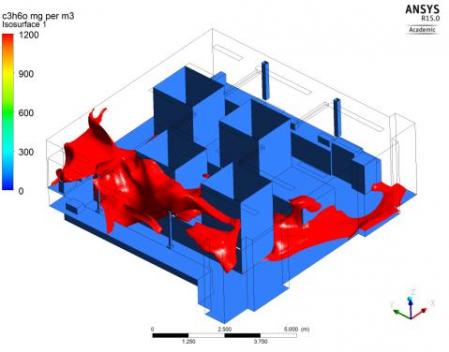
Isosurface of 1200 mg/m^3 of acetone concentration at 10 air changes per hour after 300 seconds
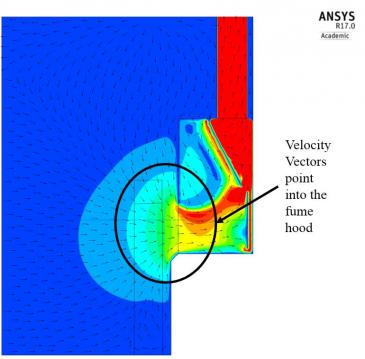
Fume hood velocity contour map of 80 feet per minute average sash velocity


